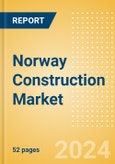Norway Construction Market Size, Trends, and Forecasts by Sector - Commercial, Industrial, Infrastructure, Energy and Utilities, Institutional and Residential Market Analysis to 2029 (H1 2025)
Summary
The analyst expects the Norwegian construction industry to expand in real terms by 2% in 2025, following contractions of 3.9% and 1.8% in 2024 and 2023 respectively. This will be supported by public and private sector investments in manufacturing, renewable energy and transport infrastructure projects and a recovery in residential construction. The growth in the Norwegian construction industry is also attributed to the recovery in the industrial construction sector which is expected to grow by 1.4% this year after registering a decline of 6.7% in 2024. In January 2025, Elinor Batteries, a Norwegian battery company announced a plan to construct a giga-scale battery production factory with an investment of NOK10 billion ($921.3 million), which will be completed by 2026. In the short term, growth will be boosted by planned expenditures under the 2025 budget. In September 2024, the government approved the 2025 Budget with a total planned expenditure of NOK2 trillion ($186.1 billion); a 6.8% increase compared to the 2024 Budget expenditure.Over the remainder of the forecast period, construction output is expected to rebound and grow at an annual average growth rate of 3.5% from 2026 to 2029, supported by investments in transport, commercial and renewable energy sectors, coupled with the government’s target of reaching net zero carbon emissions by 2030, compared to 1991 levels. In a positive development for the oil and gas sector, in January 2025, Norway’s Ministry of Petroleum and Energy awarded 53 production licenses to 20 oil and gas companies for further hydrocarbon exploration activity on the Norwegian Continental Shelf (NCS). This will enhance Norway’s ability to meet Europe’s growing energy demands.
The Construction in Norway - Key Trends and Opportunities to 2029 (H1 2025) report provides detailed market analysis, information and insights into the Norwegian construction industry, including:
- The Norwegian construction industry's growth prospects by market, project type and construction activity
- Critical insight into the impact of industry trends and issues, as well as an analysis of key risks and opportunities in the Norwegian construction industry
- Analysis of the mega-project pipeline, focusing on development stages and participants, in addition to listings of major projects in the pipeline.
Scope
This report provides a comprehensive analysis of the construction industry in Norway. It provides:
- Historical (2020-2024) and forecast (2025-2029) valuations of the construction industry in Norway, featuring details of key growth drivers.
- Segmentation by sector (commercial, industrial, infrastructure, energy and utilities, institutional and residential) and by sub-sector
- Analysis of the mega-project pipeline, including breakdowns by development stage across all sectors, and projected spending on projects in the existing pipeline.
- Listings of major projects, in addition to details of leading contractors and consultants
Reasons to Buy
- Identify and evaluate market opportunities using our standardized valuation and forecasting methodologies
- Assess market growth potential at a micro-level with over 600 time-series data forecasts
- Understand the latest industry and market trends
- Formulate and validate business strategies using the analyst's critical and actionable insight
- Assess business risks, including cost, regulatory and competitive pressures
- Evaluate competitive risk and success factors








